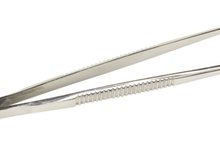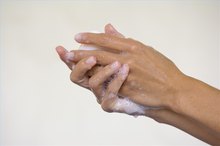How to Drown a Tick
Ticks are not insects but actually members of the arachnid family, along with spiders and scorpions. The tiny creatures suck the blood of their victims. They cannot jump or fly. Instead, ticks wait in brush for a victim to pass and then latch onto the victim. Ticks afflict humans and pets alike. They carry a variety of diseases, such as Lyme disease and Rocky Mountain spotted fever. Remove and dispose of ticks immediately.
If you are experiencing serious medical symptoms, seek emergency treatment immediately.
Grasp the tick with tweezers. Pull gently to remove the tick.
How to Remove a Tick With Oil
Learn More
Drop the tick in a bottle of rubbing alcohol. Ticks can drown 1. According to the U.S. Department of Energy, they have tiny lungs and require little air. Small bubbles allow the tick to stay alive in normal water, but if you drop the tick into alcohol, the alcohol fumes add to the liquid and cut off the tick’s oxygen supply.
Wrap the tick in a tissue and flush it down the toilet. If alcohol isn’t available, the flush method disposes of the tick. Flushing may not drown the tick, but it cuts off the ticks supply of food and the tick will die.
Tips
After removing, inspect the tick carefully. If the head is missing from the creature, look at the wound. The head may remain embedded in the skin. Treat the head as a splinter and remove with a needle.
Warnings
Do not crush the tick. If the tick is infected with anything, crushing the tick will simply spread the disease. Wash hands thoroughly after removing or handling ticks.
Related Articles
References
- US Department of Energy: Ask a Scientist, Can You Drown a Tick,
- Healthy Pet: Tick-Transmitted Diseases
- Illinois Department of Public Health: Common Ticks
- Centers for Disease Control and Prevention (CDC). Lyme Disease. CDC.gov.
- Centers for Disease Control and Prevention (CDC) staff. Tick Borne Diseases of the United States. CDC.gov.
- Centers for Disease Control and Prevention (CDC) staff. Overview of Tickborne Diseases. CDC.gov.
- Johns Hopkins Medicine, Rheumatology staff. What to do After a Tick Bite. Johns Hopkinsrheumatology.org.
- Mayo Clinic staff. Patient Care and Health Info. Tick Bites: First Aid. Mayo Clinic.org.
- Ostfeld, R. (2018) 8 Facts About the Ecology of Lyme. The Cary Institute of Ecosystem Studies. Caryinstitute.org.
- Zecken de Das Infoportal. About Ticks. Zecken.de.
Tips
- After removing, inspect the tick carefully. If the head is missing from the creature, look at the wound. The head may remain embedded in the skin. Treat the head as a splinter and remove with a needle.
Warnings
- Do not crush the tick. If the tick is infected with anything, crushing the tick will simply spread the disease.
- Wash hands thoroughly after removing or handling ticks.
Writer Bio
Based in Nashville, Shellie Braeuner has been writing articles since 1986 on topics including child rearing, entertainment, politics and home improvement. Her work has appeared in "The Tennessean" and "Borderlines" as well as a book from Simon & Schuster. Braeuner holds a Master of Education in developmental counseling from Vanderbilt University.




